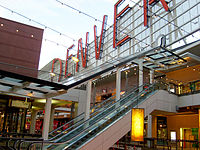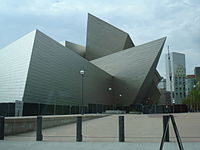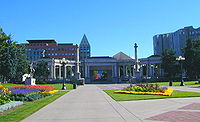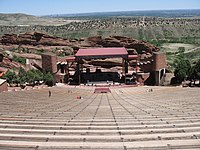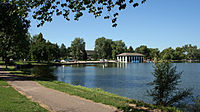Denver
Denver (/ˈdɛnvər/ DEN-vər) is a consolidated city and county, the capital, and most populous city of the U.S. state of Colorado.[1] Its population was 715,522 at the 2020 census,[23] a 19.22% increase since 2010.[11] It is the 19th-most populous city in the United States and the fifth most populous state capital. It is the principal city of the Denver–Aurora–Lakewood metropolitan statistical area, the most populous metropolitan statistical area in Colorado and the first city of the Front Range Urban Corridor.
This article is about the city and county in Colorado. For other uses, see Denver (disambiguation).
Denver
United States
Denver[1]
November 17, 1858, as
Denver City, Kansas Territory[6]
November 7, 1861, as
Denver City, Colorado Territory[7]
154.726 sq mi (400.739 km2)
153.075 sq mi (396.463 km2)
1.651 sq mi (4.276 km2)
8,403.00 sq mi (21,763.67 km2)
5,280 ft (1,610 m)
5,680 ft (1,730 m)
5,130 ft (1,560 m)
715,522
![]() 716,577
716,577
4,674/sq mi (1,805/km2)
2,686,147 (US: 18th)
4,167.5/sq mi (1,609.1/km2)
2,963,821 (US: 19th)
3,623,560 (US: 17th)
5,055,344
Denverite
$96.7 billion (2022)
$288.8 billion (2022)
08-20000
201738[22]
Denver is in the western United States, in the South Platte River Valley on the western edge of the High Plains just east of the Front Range of the Rocky Mountains. Its downtown district is immediately east of the confluence of Cherry Creek and the South Platte River, about 12 miles (19 kilometres) east of the foothills of the Rocky Mountains. It is named after James W. Denver, a governor of the Kansas Territory. It is nicknamed the Mile High City because its official elevation is exactly one mile (5280 feet or 1609.344 meters) above sea level.[a][24] The 105th meridian west of Greenwich, the longitudinal reference for the Mountain Time Zone, passes directly through Denver Union Station.
Denver is ranked as a Beta world city by the Globalization and World Cities Research Network. The 10-county Denver–Aurora–Lakewood, CO Metropolitan Statistical Area had a population of 2,963,821 at the 2020 United States census, making it the 19th most populous U.S. metropolitan statistical area.[11] The 12-county Denver–Aurora, CO Combined Statistical Area had a population of 3,623,560 at the 2020 U.S. census, making it the 17th most populous U.S. primary statistical area.[11] Denver is the most populous city of the 18-county Front Range Urban Corridor, an oblong urban region stretching across two states with a population of 5,055,344 at the 2020 U.S. census.[11] Its metropolitan area is the most populous within a 560-mile (900 km) radius and it is the second-most populous city in the Mountain West after Phoenix, Arizona. In 2016, it was named the best place to live in the United States by U.S. News & World Report.[25]
Apollo Hall opened soon after the city's founding in 1859 and staged many plays for eager settlers.[39] In the 1880s Horace Tabor built Denver's first opera house. After the start of the 20th century, city leaders embarked on a city beautification program that created many of the city's parks, parkways, museums, and the Municipal Auditorium, which was home to the 1908 Democratic National Convention and is now known as the Ellie Caulkins Opera House. Denver and the metropolitan areas around it continued to support culture.
In July 1982, Denver hosted the World Theatre Festival[121] at the Denver Center for Performing Arts, which comprised a program of 114 performances of 18 plays, by theatre companies from 13 countries, across 25 days.[122]
In 1988, voters in the Denver Metropolitan Area approved the Scientific and Cultural Facilities Tax (commonly known as SCFD), a 0.1% (1 cent per $10) sales tax that contributes money to various cultural and scientific facilities and organizations throughout the Metro area.[123] The tax was renewed by voters in 1994 and 2004 and allowed the SCFD to operate until 2018.[124] Ballot issue 4B in 2016 won approval 62.8 percent to 37.2 percent, by Denver metro area voters, to extend the SCFD sales tax until 2030.[125]
Denver is home to a wide array of museums.[126] Many are nationally recognized, including a new wing for the Denver Art Museum by architect Daniel Libeskind, the nation's second-largest Performing Arts Center after Lincoln Center in New York City, and bustling neighborhoods such as LoDo, filled with art galleries, restaurants, bars and clubs. That is part of the reason Denver was, in 2006, recognized for the third year in a row as the best city for singles.[127] Its neighborhoods also continue their influx of diverse people and businesses while the city's cultural institutions grow and prosper. The city acquired the estate of abstract expressionist painter Clyfford Still in 2004 and built a museum to exhibit his works near the Denver Art Museum.[128] The Denver Museum of Nature and Science holds an aquamarine specimen valued at over $1 million, as well as specimens of the state mineral, rhodochrosite. Every September the Denver Mart, at 451 E. 58th Avenue, hosts a gem and mineral show.[129] The state history museum, History Colorado Center, opened in April 2012. It features hands-on and interactive exhibits, artifacts and programs about Colorado history.[130] It was named in 2013 by True West Magazine as one of the top-ten "must see" history museums in the country.[131] History Colorado's Byers-Evans House Museum and the Molly Brown House are nearby.
Denver has numerous art districts, including Denver's Art District on Santa Fe and the River North Art District (RiNo).[132]
While Denver may not be as recognized for historical musical prominence as some other American cities, it has an active pop, jazz, jam, folk, metal, and classical music scene, which has nurtured several artists and genres to regional, national, and even international attention. Of particular note is Denver's importance in the folk scene of the 1960s and 1970s. Well-known folk artists such as Bob Dylan, Judy Collins and John Denver lived in Denver at various points during this time and performed at local clubs.[133] Three members of the widely popular group Earth, Wind, and Fire are also from Denver. More recent Denver-based artists include India Aire, Nathaniel Rateliff & the Night Sweats, The Lumineers, Air Dubai, The Fray, Flobots, Cephalic Carnage, Axe Murder Boyz, Deuce Mob, Havok, Bloodstrike, Primitive Man, and Five Iron Frenzy. Denver is also home to the Denver Record Collectors Expo, a biannual music collectors event.
Because of its proximity to the mountains and generally sunny weather, Denver has gained a reputation as being a very active, outdoor-oriented city. Many Denver residents spend the weekends in the mountains; skiing in the winter and hiking, climbing, kayaking, and camping in the summer.
Denver and surrounding cities are home to a large number of local and national breweries. Many of the region's restaurants have on-site breweries, and some larger brewers offer tours, including Coors and New Belgium Brewing Company. The city also welcomes visitors from around the world when it hosts the annual Great American Beer Festival each fall.
Denver used to be a major trading center for beef and livestock when ranchers would drive (or later transport) cattle to the Denver Union Stockyards for sale. As a celebration of that history, for more than a century Denver has hosted the annual National Western Stock Show, attracting as many as 10,000 animals and 700,000 attendees. The show is held every January at the National Western Complex northeast of downtown.
Denver has one of the country's largest populations of Mexican Americans and hosts four large Mexican American celebrations: Cinco de Mayo (with over 500,000 attendees),[134] in May; El Grito de la Independencia, in September; the annual Lowrider show, and the Dia De Los Muertos art shows/events in North Denver's Highland neighborhood, and the Lincoln Park neighborhood in the original section of West Denver.
Denver is known for its dedication to New Mexican cuisine and the chile. It is best known for its green and red chile sauce, Colorado burrito, Southwest (Denver) omelette, breakfast burrito, empanadas, chiles rellenos, and tamales. Denver is also known for other types of food such as Rocky Mountain oysters, rainbow trout, and the Denver sandwich.
The Dragon Boat Festival in July, Moon Festival in September and Chinese New Year are annual events in Denver for the Chinese and Asian-American communities. Chinese hot pot (huo guo) and Korean BBQ restaurants have been growing in popularity. The Denver area has two Chinese newspapers, the Chinese American Post and the Colorado Chinese News.[135] A Korean Newspaper, the "Colorado Times News" is also based in Denver.[136]
Denver has long been a place tolerant of the LGBTQ (lesbian, gay, bisexual, transgender, and queer) community. Many gay bars can be found on Colfax Avenue and on South Broadway. Every June, Denver hosts the annual Denver PrideFest in Civic Center Park, the largest LGBTQ Pride festival in the Rocky Mountain region.[137]
Denver is the setting for The Bill Engvall Show, Tim Allen's Last Man Standing and the 18th season of MTV's The Real World. It was also the setting for the prime time drama Dynasty from 1981 to 1989 (although the show was mostly filmed in Los Angeles). From 1998 to 2002 the city's Alameda East Veterinary Hospital was home to the Animal Planet series Emergency Vets, which spun off three documentary specials and the current Animal Planet series E-Vet Interns. The city is also the setting for the Disney Channel sitcom Good Luck Charlie.
Denver is home to a variety of sports teams and is one of 12 U.S. cities with teams from four major league sports (the Denver metro area is the smallest metropolitan area in the country to have a team in all four major sports leagues). Including MLS soccer, it is also one of 10 U.S. cities to have five major sports teams.
The Denver Broncos of the National Football League have drawn crowds of over 70,000 since their origins in the early 1960s, and continue to draw fans today to their current home Empower Field at Mile High. The Broncos have sold out every home game (except for strike-replacement games) since 1970.[138] The Broncos have advanced to eight Super Bowls and won back-to-back titles in 1997 and 1998, and won again in 2015.
The Colorado Rockies were created as an expansion franchise in 1993 and Coors Field opened in 1995. The Rockies advanced to the playoffs that year but were eliminated in the first round. In 2007, they advanced to the playoffs as a wild-card entrant, won the NL Championship Series, and brought the World Series to Denver for the first time but were swept in four games by the Boston Red Sox.
Denver has been home to two National Hockey League teams. The Colorado Rockies played from 1976 to 1982, but later moved to the New York metropolitan area to become the New Jersey Devils. The Colorado Avalanche joined in 1995, after relocating from Quebec City. While in Denver, they have won three Stanley Cups in 1996, 2001, and 2022. The Denver Nuggets joined the American Basketball Association in 1967 and the National Basketball Association in 1976. The Nuggets won their first NBA championship in 2023. The Avalanche and Nuggets have both played at Ball Arena (formerly known as Pepsi Center) since 1999. The Major League Soccer team Colorado Rapids play in Dick's Sporting Goods Park, an 18,000-seat soccer-specific stadium opened for the 2007 MLS season in the Denver suburb of Commerce City.[139] The Rapids won the MLS Cup in 2010.
Denver has several additional professional teams. In 2006, Denver established a Major League Lacrosse team, the Denver Outlaws. They play in Empower Field at Mile High. In 2006, the Denver Outlaws won the Western Conference Championship and then won their first championship in 2014 eight years later. They also won in 2016 and 2018 and would fold in 2020 with the MLL-PLL merger. The Colorado Mammoth of the National Lacrosse League play at Ball Arena. They won championships in 2006 and 2022.
In 2018, the Denver Bandits were established as the first professional football team for women in Colorado and will be a part of the initial season for the Women's National Football Conference (WNFC) in 2019.
Denver submitted the winning bid to host the 1976 Winter Olympics but subsequently withdrew, giving it the distinction of being the first city to back out after having won its bid to host the Olympics.[57] Denver and Colorado Springs hosted the 1962 World Ice Hockey Championships.
As of 2006, Denver had over 200 parks, from small pocket parks all over the city to the giant 314-acre (1.27 km2) City Park.[145] Denver also has 29 recreation centers providing places and programming for resident's recreation and relaxation.[146]
Many of Denver's parks were acquired from state lands in the late 19th and early 20th centuries. This coincided with the City Beautiful movement, and Denver mayor Robert Speer (1904–12 and 1916–18) set out to expand and beautify the city's parks. Reinhard Schuetze was the city's first landscape architect, and he brought his German-educated landscaping genius to Washington Park, Cheesman Park, and City Park among others. Speer used Schuetze as well as other landscape architects such as Frederick Law Olmsted Jr. and Saco Rienk DeBoer to design not only parks such as Civic Center Park, but many city parkways and tree-lawns. Cheesman Park neighbor the Denver Botanic Gardens displays the beauty and versatility of micro-climates within the semi-arid Denver Basin. All of these parks were fed with South Platte River water diverted through the city ditch.[147]
In addition to the parks within Denver, the city acquired land for mountain parks starting in the 1911s.[148] Over the years, Denver has acquired, built and maintained approximately 14,000 acres (57 km2) of mountain parks, including Red Rocks Park, which is known for its scenery and musical history revolving around the unique Red Rocks Amphitheatre.[149][150] Denver also owns the mountain on which the Winter Park Resort ski area operates in Grand County, 67 miles (110 km) west of Denver.[151] City parks are important places for Denverites and visitors, inciting controversy with every change. Denver continues to grow its park system with the development of many new parks along the Platte River through the city, and with Central Park and Bluff Lake Nature Center in the Central Park neighborhood redevelopment. All of these parks are important gathering places for residents and allow what was once a dry plain to be lush, active, and green. Denver is also home to a large network of public community gardens, most of which are managed by Denver Urban Gardens, a non-profit organization.
Since 1974, Denver and the surrounding jurisdictions have rehabilitated the urban South Platte River and its tributaries for recreational use by hikers and cyclists. The main stem of the South Platte River Greenway runs along the South Platte 35 miles (56 km) into Adams County in the north. The Greenway project is recognized as one of the best urban reclamation projects in the U.S., winning, for example, the Silver Medal Rudy Bruner Award for Urban Excellence in 2001.[152]
As of 2022, ParkScore by the Trust for Public Land, a national land conservation organization, reported Denver as having the 18th best park system among the 50 most populous U.S. cities. The report noted that 89% of Denverites live within a 10-minute walk of a park.[153]
Denver Public Schools (DPS) is the public school system in all of Denver.[173] It educates approximately 92,000 students in 92 elementary schools, 44 K-8 schools, 34 middle schools, 18 high schools, and 19 charter schools.[174] The first school of what is now DPS was a log cabin that opened in 1859, which later became East High School. East High School, along with the other three directional high schools (West, North, and South), made up the first four high schools in Denver.[175] The district boundaries are coextensive with the city limits.[176] The Cherry Creek School District serves some areas with Denver postal addresses that are outside the city limits.[176][177]
Denver's many colleges and universities range in age and study programs. Three major public schools constitute the Auraria Campus: the University of Colorado Denver, Metropolitan State University of Denver, and Community College of Denver. The private University of Denver was the first institution of higher learning in the city and was founded in 1864. Other prominent Denver higher education institutions include Johnson & Wales University, Catholic (Jesuit) Regis University and the city has Roman Catholic and Jewish institutions, as well as a health sciences school. In addition to those schools within the city, there are a number of schools throughout the surrounding metro area.
